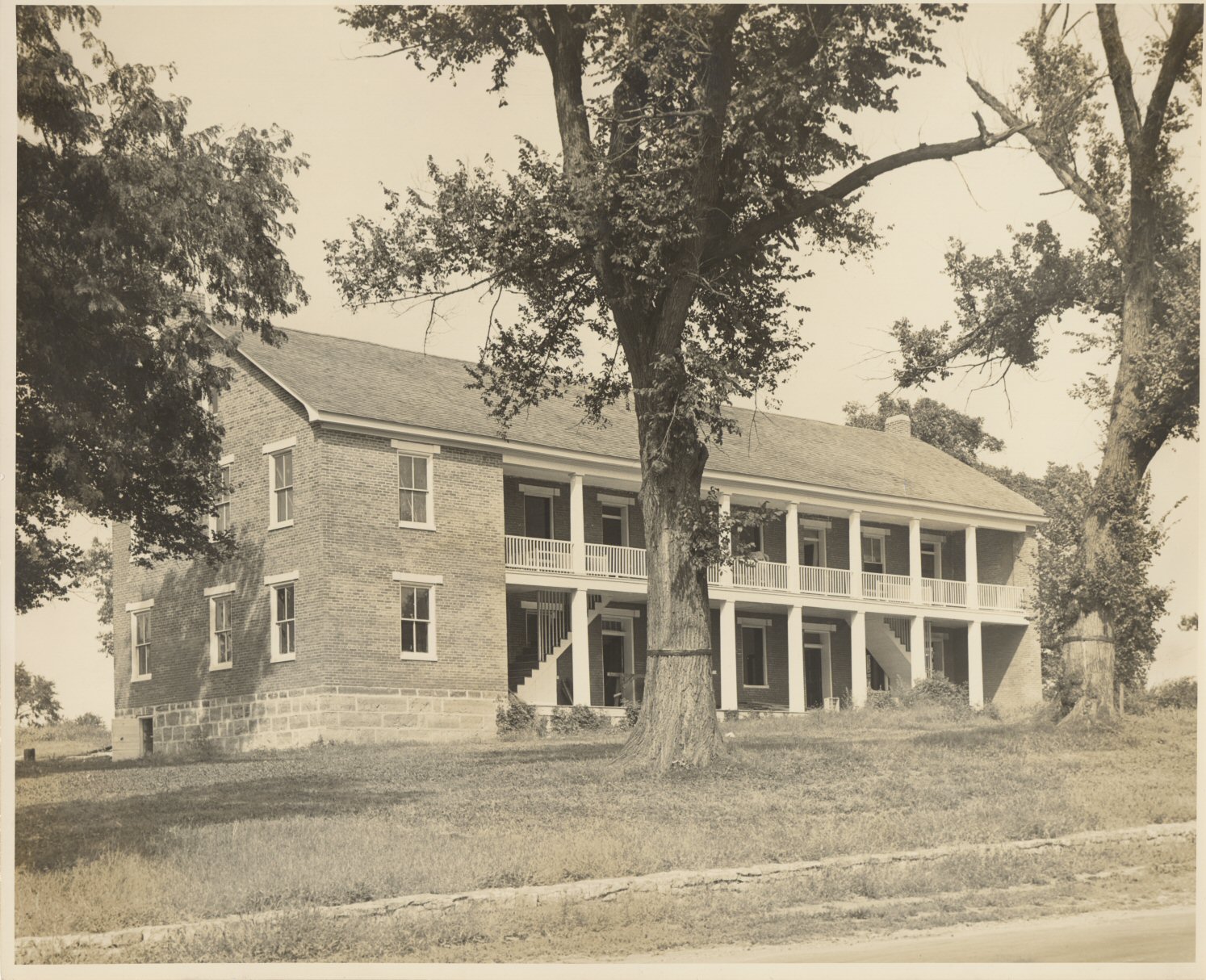Guest written by Jennifer Laughlin, Site Director, Shawnee Indian Mission National Historic Landmark
The Johnson County Museum is hosting Away from Home: American Indian Boarding School Stories through March 18, 2023. The nationally touring exhibit from Kansas City’s Mid-America Arts Alliance explores the history of the federal, off-reservation Indian boarding schools in operation between the 1870s and the 1980s. What is today known as Haskell Indian Nations University in Lawrence, Kansas was the closest federal, off-reservation boarding school to Johnson County. The exhibit does not tell the story of the Shawnee Indian Mission State Historic Site in Fairway, Kansas, however. The Shawnee Indian Mission history has been featured in several blogs on JoCoHistory.org (more here), but the site’s role in state history is lesser known. For today’s blog, staff at the Shawnee Indian Mission State Historic Site compiled four things readers might not know about the Shawnee Indian Mission.

Surrounded by residential homes, a private high school, and the 53rd Street thoroughfare, many people drive through what is considered the most important historic site in the state of Kansas – the Shawnee Indian Mission National Historic Landmark in Fairway, Kansas – every day. And yet many do so without knowing what it is and why these nearly 12 acres in northeast Johnson County are a national historic landmark. Below are four facts from the long history of the Shawnee Indian [Methodist] Mission.
1. Two Locations
The Fairway site is actually the second site of the Shawnee Methodist Mission. The first was located on a wooded bluff of the Kansas River, southeast of present-day Turner in Wyandotte County. The Fish band of the Shawnee Tribe accepted a Methodist proposal for establishing a mission school in 1830. The one-room school building was ready by the spring of 1831. By the fall of 1835, the school had 34 students, 19 of whom lived on-site. The other 15 received one meal a day at school and returned home to their parents each night. Students learned in both English and their native languages (under the supervision of Native class leaders). Students were taught cabinet making, shoe cobbling, and other trades at the school. By 1838, the school had a waitlist and plans were made to build a larger school in Fairway. Neither school location had forced, federally mandated enrollment like the schools covered in Away from Home. That practice became common after the mission closed.

2. Site of a Vote for Slavery in Kansas
The Shawnee Indian Mission State Historic Site played an important political role in early Kansas State history. Andrew Reeder, the first governor of the Kansas Territory, kept offices in the North building of the Shawnee Indian Mission when he arrived in the Territory in October of 1854. In July 1855, when school was on summer break and students were back with their families, the Kansas Territorial Legislature (sometimes called the Bogus Legislature) met in the Mission’s East building to pass a bill moving the statehood vote to the Shawnee Indian Mission near pro-slavery Missouri. Governor Reeder, who supported the concept of popular sovereignty (letting the residents of the Kansas Territory decide whether slavery would be allowed in Kansas), was in support of the vote. When the legislature gathered, Governor Reeder announced that President Pierce had removed him from office. Nonetheless, the legislature voted on a slave code for the territory. With this “bogus” vote, Kansas was deemed a slave state. Abolitionists worked to have the vote thrown out. Eventually, the pro-slavery government left the mission site and moved to Lecompton, Kansas.

3. A Civil War Encampment
The site was also significant in the Civil War. In 1862, as Kansas and Missouri’s Border War intensified, Union Captain E. Harvey reported that his 6th Kansas Cavalry Regiment had been encamped at the Shawnee Indian Mission for two months. The school soon closed and by July 31, 1863, General Thomas Ewing, Jr. established a Union military post at the site to protect Kansas from Missouri guerilla raiders. The 6th Regiment used the buildings to care for and as quarters for Union troops. On the north end of the East building, there is a noticeable difference in brick color that is slightly circular in shape. A historical account says that it was the result of a cannon ball hitting the building, most likely a misfire during Union training exercises. In October 1864, reports detailed that 12,000 militiamen were in the Mission’s vicinity. These troops helped defeat General Price’s Confederate troops at the Battles of Big Blue and Westport. After the Civil War, the Mission remained private property until 1927.

4. A National Historic Landmark
In 1927, the State of Kansas acquired the mission site by eminent domain – the only time eminent domain has been used in this way in Kansas. The site opened as a museum two years later in 1929 as the Shawnee Indian Mission State Historic Site. In 1968, the site was named a National Historic Landmark. This highest designation in the country was bestowed on the site because of its national significance in terms of places, people, and events that illustrate the history of the United States.

To learn more about the history of the Shawnee Indian Mission State Historic Site in Fairway, view historical markers on the property and explore the interior of the Mission site during public operating hours Wednesday through Saturday, 10am to 5pm. Learn more and plan your visit.
Visit the Johnson County Museum’s special exhibit, Away from Home, about federal, off-reservation Indian boarding schools through Saturday, March 18. The Museum is open Monday through Saturday, 9am to 4:30pm, and there will be upcoming programs associated with the exhibit. Learn more at www.jcprd.com/Museum.
